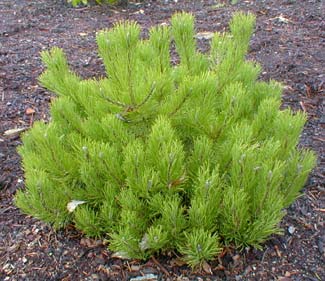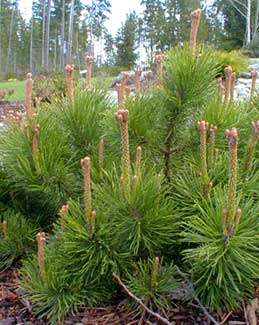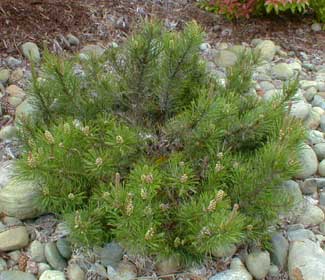
Dwarf Mugo Pine; or,
Dwarf Mountain Pine; or,
Swiss Mountain Pine
"Somehow it seems sufficient
to see and hear whatever coming & going is,
losing the self to the victory
of stones and trees,
of bending sandpit lakes, crescent
round groves of dwarf pine."
-A. A. Ammons
(1926-2001)
(1926-2001)
The photos show three different dwarf Mugo pines in different locations of a friend's garden in which I've done a great deal of work. The first photo was snapped in February, the second in April.
In selecting plants for a landscape I personally would never have recommended Mugo, but that's only because it is so common. But the sparsely planted gardens when the house were purchased already had some common things. And regularly observing these specimens, I've come to like them a great deal, & certainly see why they've become such standards.
Pinus mugo, is frequently listed under the variant spellings P. mughus & P. mugho, & the species is synonymous with P. montanus. A common mispelling adds an extra letter to this pine's name so that it becomes Mungo or Mungho, after Saint Mungo, Bishop of Strathclyde, Scotland, circa 540 C.E.
Saint Mungo's name means "Dear One." One of his first reported miracles was restoring a serf's pet robin to life after ruffians had killed it, borrowing from Arabic "Infancy gospels" in which child Jesus did the same with doves slain by wicked playmates.
The correct name Mugo, however, is of such old origin that the meaning is lost to time. It may be an old Italian dialect word for "mountain," or possibly tracks back to a Nordic word meaning "misty" for growing in mists of high mountain plateaus & ledges.
 There are two subspecies. The larger is the tree form P. mugo uncinata in the northern range of the species (in the Pyrenees), sometimes regarded as a separate species, P. uncinata. The widely gardened mugo shown here is the shrub form, P. mugo mugo, native to the Carpathian Mountains, Alps, Appennines of southern Italy, & the mountains of the Balkan Penninsula. The ranges of the two subspecies overlap in the Western Alps.
There are two subspecies. The larger is the tree form P. mugo uncinata in the northern range of the species (in the Pyrenees), sometimes regarded as a separate species, P. uncinata. The widely gardened mugo shown here is the shrub form, P. mugo mugo, native to the Carpathian Mountains, Alps, Appennines of southern Italy, & the mountains of the Balkan Penninsula. The ranges of the two subspecies overlap in the Western Alps.In form it typically develops early in its life into a dome two to three feet tall & three or four feet wide, made up of upright stems of deep green needles. Its evergreen branches give the appearance of reaching upward right from off the ground, for its curving or prostrate trunk or trunks are not always visible, unless specifically trained through pruning for a visible stubby trunk. Over time it very slowly takes on a flatter & wider look, until it is as much as six or eight feet wide, yet sometimes still only three or four feet tall.
The trunk or trunks lean at such a strong angle they are virtually creeping along the ground. This habit is an adaptation to life in avalanche regions at alpine treelines.
There are many strains in the marketplace & occasionally a specimen will have much more rapid growth & spring up to a six or even ten foot shrub. These larger specimens without the strongly angled or creeping habit are likely hybridized with P. mugo uncinata. Such specimens can in the long run become twenty feet tall. In the past its unpredictability of size has been a problem for gardeners who expected it to remain dwarf. A few modern cultivars such as 'Mops' & 'Slowmound' are more certain to remain under five feet in ten years.
 A good guess can be made as to whether a given specimen is likely to remain short. Merely part the limbs & assess whether the trunk is developing a more upright structure or is properly prostrate.
A good guess can be made as to whether a given specimen is likely to remain short. Merely part the limbs & assess whether the trunk is developing a more upright structure or is properly prostrate.By judicious pruning its slow growth can be further restricted so that it can be kept as a more compact little dome indefinitely. If the pruning route is undertaken, it should be done in late winter or early spring as new needles are emerging, otherwise one could be stuck with truncated-looking limbs. New young "candles" appear as early as April (when the second photo was snapped showing a mugo with brand new candles), or in summer; & these can be removed if there is a desire to keep the shrub particularly small. Tip-pruning or candling will greatly reduce production of cones which tend to appear at the tips, & pruning is certainly not required for the health of the shrub.
It is often chosen for bonsai because already a tough dwarf with naturally twisted & leaning trunk(s), easily forced to remain in an even smaller state. It's also a good choice for larger container gardening, & can even be tried as a hedgeable shrub though to get a good hedge from it takes very careful pruning technique; mere shearing will invariably render these shrubs homely.
A single shrub produces both male & female cones. Female cones start out green, ripening to violet, then dark brown by October. The cone bursts open to disperse winged seeds the following spring. The female cones occur singly or in pairs at branch tips, though the tree extends its height with "candles" in summer, when female cones may be seen at the base of new candles even though they were at the tips when they first deeloped.
After female cones disperse winged seeds, the round emptied cone falls to the ground intact, so are potentially useful in dry flower arrangement by gluing them to branches.
The male cones are smaller, yellow or reddish, & nested lower in the shrub. Cones can take two or even three years to ripen so that a mature specimen will have cones year-round. It can take many years before it begins to produce the cones.
Mugo pine should not be fertilized, though a mulch every other year of well-composted manure doesn't hurt it. It wants full sun, but is one of the few pines that will also do well in bright shade, though here on Puget Sound its shade tolerance should not be tested.
It is very adaptable for soil conditions, accepting sandy or loamy conditions, alkaline to acidic. In its high-mountain natural environment it is often to be seen on cliffs or other areas in shallow rocky soil, for which reason it is one of the few pines that are easily transplanted. For the garden mugo is a good choice for troublesome spots where few shrubs other than junipers are easily established.
Its one foe is dampness & may languish & fail in soil that does not drain well. It does well with regular to moderate watering, but is drought tolerant for the xeriscape garden once it is established & may need no watering at all, unless once a month in dry summers. However, it can be heat sensitive in Zone 9 & may need more careful watering during lengthy sunny droughts, or nearby shrubs of like size to protect it just a little. On the other hand it is very cold-hardy & can be grown down to USDA Zone 3, just so long as it has some protection (provided by nearby shrubs) against desicating winter winds.
Throughout its range, in European folk medicine, a turpentine distillate extracted from the needles & young wood has been taken internally to treat soar throats, bronchitis, & heart & renal disease, & applied externally for muscle pain & rheumatism.
Its actual efficacy for the many ailments it purportedly assists remains unproven for most claims, but sap or needle extract of all species of pine throughout the northern hemisphere do have analgesic & antimicrobial properties, & have been used as natural cough remedies virtually everywhere in the world where pines are found. Mugo turpentine is also used as a varnish & for other products.
In Bulgaria mugo pine is called Klek, "Prostrate," & the resinous sap is used by mountain people to brew a pleasing nearly vanilla-scented tea. The sap can be extracted by "tapping" a living tree, but is rarely obtained in sufficient quantities to have a commercial value beyond folk use.
The resin does have commercial uses as a by-product of distilling the needles & young wood to separate the turpentine. The remaining resinous matter is called rosen, traditionally used for violin bows & as a sealing wax.
The terpene in the needles is a growth suppressant for grasses & will keep many plants from germinating in the immediate vicinity of the shrub. This adaptation facilitates its slow sideways spread, insuring no faster growing shrubs or trees will horn in on its ground. In consequence, for the garden, it is best not to try to establish smaller plants right beside it.
Wood of the mugo is very hard by right of its slow growth, & was once commonly used to make wooden clogs. In today's throw-away consumer economies, softer pinewoods have displaced mugo, being vastly cheaper.